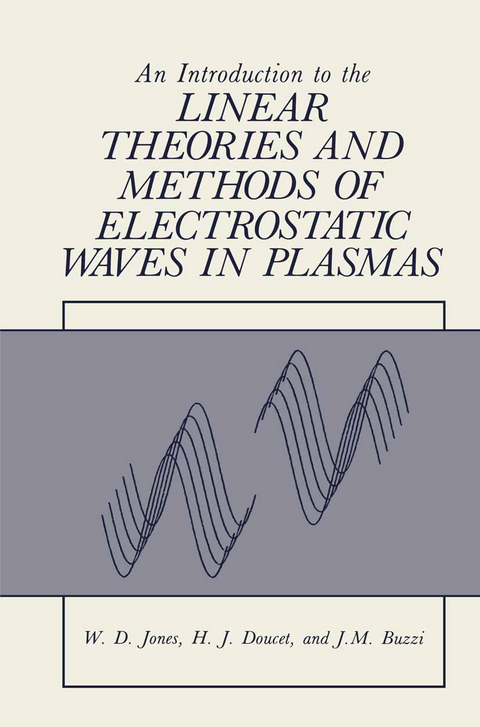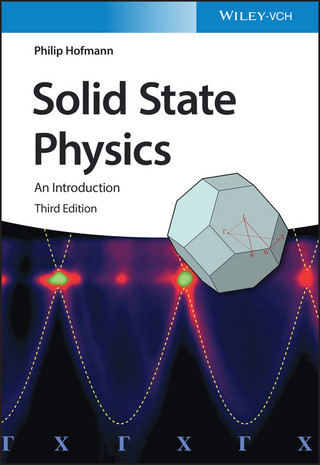
An Introduction to the Linear Theories and Methods of Electrostatic Waves in Plasmas
Springer-Verlag New York Inc.
978-1-4757-0213-2 (ISBN)
1. The Cookbook: Fourier, Laplace, and Hilbert Transforms.- 1.1. Introduction.- 1.2. A Basic Example: Electromagnetic-Wave Propagation in Vacuum.- 1.3. The Fourier-Laplace Transforms.- 1.4. Laplace Transforms and Causality.- 1.5. Hilbert Transforms.- 1.6. Appendix A: Functions of Complex Variables.- 2. Waves in a Conductivity-Tensor-Defined Medium: A Cold-Plasma Example.- 2.1. Introduction.- 2.2. Waves in Idealized Media.- 2.3. Waves in Plasmas.- 2.4. Waves in a Cold Plasma.- 2.5. Applications of the Cold-Plasma-Theory Results.- 2.6. Selected Experiment: A Simple Transmission Experiment Using the Extraordinary Wave to Measure Plasma Density.- 3. Electrostatic Waves in a Warm Plasma: A Fluid-Theory Example.- 3.1. Introduction.- 3.2. Dispersion Relation for Purely Electrostatic Waves in a Warm Plasma.- 3.3. Electrostatic Modes in a Warm Plasma.- 3.4. Selected Experiments.- 4. Ion-Acoustic Waves with Ion-Neutral and Electron-Neutral Collisions.- 4.1. Introduction.- 4.2. Dispersion Relation with Collisions.- 4.3. Initial-Value Problem.- 4.4. Boundary-Value Problem.- 4.5. Selected Experiment: Boundary-Value Problem for Ion-Acoustic Waves in a Collision-Dominated Discharge Plasma.- 5. Finite-Size-Geometry Effects.- 5.1. Introduction.- 5.2. Electron Plasma Waves in a Cold Plasma Supported by a Strong Magnetic Field.- 5.3. Ion-Acoustic Waves in a Warm Plasma Supported by a Strong Magnetic Field.- 5.4. Selected Experiments.- 6. Ion-Acoustic Waves in a Small Density Gradient.- 6.1. Introduction.- 6.2. Wave Equation.- 6.3. Wave Propagation in a Nonuniform Plasma Having a Gaussian Density Profile.- 6.4. Wave Propagation in a Nonuniform Plasma Having an Arbitrary Density Profile.- 6.5. Wave Propagation in a Uniform Plasma Having a Subsonic Density Gradient at its Edge.- 6.6. Selected Experiments.- 7. Landau Damping: An Initial-Value Problem.- 7.1. Introduction.- 7.2. Collisionless Damping Due to Free Streaming.- 7.3. Longitudinal Oscillations in an Infinite, Homogeneous Plasma with No Applied Fields—The Electron Plasma Wave.- 7.4. Ion-Acoustic Waves.- 8. Kinetic Theory of Forced Oscillations in a One-Dimensional Warm Plasma.- 8.1. Introduction.- 8.2. Microscopic Theory of Forced Oscillations.- 8.3. Difficulties Encountered in the Forced-Oscillations Problem.- 8.4. Free-Streaming and Collective Effects.- 8.5. Physical Meaning of Landau Damping.- 9. Computing Techniques for Electrostatic Perturbations.- 9.1. Introduction.- 9.2. Dielectric Constant of a Maxwellian Electron Cloud.- 9.3. The Gould Technique.- 9.4. The Derfler-Simonen Technique.- 9.5. The Hybrid Technique.- 9.6. Conclusions.- 9.7. Appendix: Plasma Wave Functions.- 10. Ion-Acoustic Waves in Maxwellian Plasmas: A Boundary-Value Problem.- 10.1. Introduction.- 10.2. Dispersion Relation for Ion-Acoustic Waves.- 10.3. Ion-Acoustic Waves in an Isothermal Plasma.- 10.4. Selected Experiment: Landau Damping of Ion-Acoustic Waves in a Nonisothermal Plasma.- 11. Numerical Methods.- 11.1. Introduction.- 11.2. Numerical Evaluation of Hilbert Transforms.- 11.3. Hunting the Roots of a Dispersion Relation.- 11.4. Appendix.- References.
| Zusatzinfo | XV, 312 p. |
|---|---|
| Verlagsort | New York, NY |
| Sprache | englisch |
| Maße | 155 x 235 mm |
| Themenwelt | Naturwissenschaften ► Physik / Astronomie ► Atom- / Kern- / Molekularphysik |
| ISBN-10 | 1-4757-0213-2 / 1475702132 |
| ISBN-13 | 978-1-4757-0213-2 / 9781475702132 |
| Zustand | Neuware |
| Haben Sie eine Frage zum Produkt? |
aus dem Bereich


